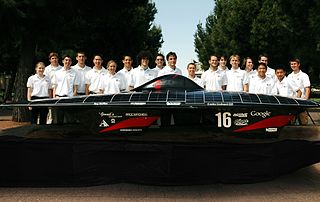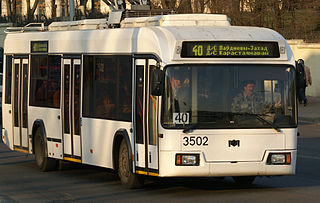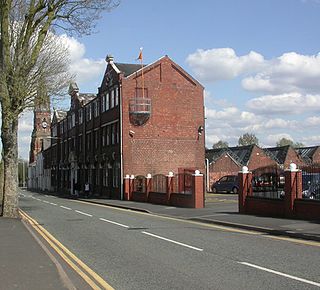The Solar Resource was an Australian entry in the inaugural World Solar Challenge race—then known as the Pentax World Solar Challenge race—in 1987.

The World Solar Challenge or the Bridgestone World Solar Challenge since 2013 due to the sponsorship of Bridgestone Corporation is a biennial solar-powered car race which covers 3,022 km (1,878 mi) through the Australian Outback, from Darwin, Northern Territory to Adelaide, South Australia.
The Solar Resource was one of 24 entries from 7 countries (Australia, Denmark, Japan, Pakistan, Switzerland, United States and West Germany) which raced from Darwin to Adelaide, a journey of just over 3000 km. The Solar Resource finished 7th overall, but came first in the ‘Private Entry’ category. [1] Its overall average speed during the race 25.64 km/h. The race was won by the US-built GM entry, Sunraycer.

Pakistan, officially the Islamic Republic of Pakistan, is a country in South Asia. It is the world’s sixth-most populous country with a population exceeding 212,742,631 people. In area, it is the 33rd-largest country, spanning 881,913 square kilometres. Pakistan has a 1,046-kilometre (650-mile) coastline along the Arabian Sea and Gulf of Oman in the south and is bordered by India to the east, Afghanistan to the west, Iran to the southwest, and China in the far northeast. It is separated narrowly from Tajikistan by Afghanistan's Wakhan Corridor in the northwest, and also shares a maritime border with Oman.

West Germany is the common English name for the Federal Republic of Germany in the period between its creation on 23 May 1949 and German reunification on 3 October 1990. It lied between the North Sea to the north, and the Alps to the south. It bordered Denmark to the north, East Germany and Czechoslovakia to the east, Austria and Switzerland to the south, France to the southwest, and Luxembourg, Belgium and the Netherlands to the west. During this Cold War era, NATO-aligned West Germany and Warsaw Pact-aligned East Germany were divided by the Inner German border. After 1961 West Berlin was physically separated from East Berlin as well as from East Germany by the Berlin Wall. This situation ended when East Germany was dissolved and split into five states, which then joined the ten states of the Federal Republic of Germany along with the reunified city-state of Berlin. With the reunification of West and East Germany, the Federal Republic of Germany, enlarged now to sixteen states, became known simply as "Germany". This period is referred to as the Bonn Republic by historians, alluding to the interwar Weimar Republic and the post-reunification Berlin Republic.

The Sunraycer was a solar powered race car designed to compete in the world's first race featuring solar-powered cars. This race is now called the World Solar Challenge. The Sunraycer, a joint collaboration between General Motors, AeroVironment, and Hughes Aircraft, won the first race in 1987 by a huge margin. The teams lead driver was Australian John Harvey, a driver with nearly 40 years experience racing speedcars (Speedway), open wheelers, sports cars and touring cars. Harvey was involved with the testing and development of the Sunraycer at the General Motors Proving Ground, Arizona.
The Solar Resource was an Australian privately funded backyard project, headed by Ian Landon Smith, an engineer and alternative energy specialist during 1986-7. During that time, each component of the Solar Resource was made and re-made 3 times prior to a successful final construction. While the cost of building the car was approximately $75,000, almost $1 million on the 760 gallium-arsenide solar cells, usually used on space satellites.
The dimensions of the Solar Resource include a height of 1.04 metres, a width of 2 metres and a depth of 5.43 metres, with a total weight of 170 kg. It is powered by an electric motor that is Swiss-made, which has a variable drive, chain drive to its rear wheels. Built around a square tube frame, the body is set very low to the ground and is square in section, but with a rounded nose, which features four holes for ventilation. The cockpit cover is made of removable fibreglass, while the body panels are made of fibreglass, mylar and Kevlar. Attached to the roof, just above the tinted windscreen, is an externally mounted rear-view mirror which functions in the same manner as a ‘periscope’. The pneumatic tyres have four orange-coloured lights in each corner of the ‘hubcap’ which act as indicators. The axles are covered with white aerofoil and extend out from the body; the two front axles extend out further than the two rear ones. [2]

A rear-view mirror is a Convex mirror in automobiles and other vehicles, designed to allow the driver to see rearward through the vehicle's rear window.
The cockpit itself features polystyrene panels in the sides around the horizontally positioned aluminium tube frame seat. Two bottles are located behind the seat – one for drinking has a tube attached, and the other is for squirting and cooling purposes. Also behind the seat are two 12-volt Pulsar batteries. In front of the seat, the control panel contains digital readout instruments for the voltage and amp readings of both, the battery and the solar cells. Because of its racing context, a clock and stop watch are also part of the control panel. There is also a twenty-channel CB radio beneath the control panel. The steering wheel, shaped like a boomerang, is set in the centre. [3]
Smith donated the Solar Resource to the Powerhouse Museum in 1990.

The Powerhouse Museum is the major branch of the Museum of Applied Arts & Sciences in Sydney, the other being the historic Sydney Observatory. Although often described as a science museum, the Powerhouse has a diverse collection encompassing all sorts of technology including decorative arts, science, communication, transport, costume, furniture, media, computer technology, space technology and steam engines.















